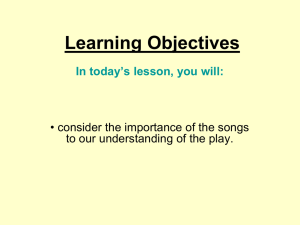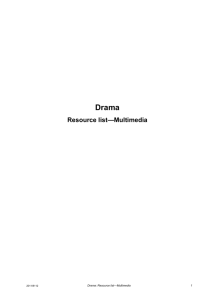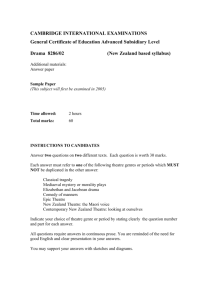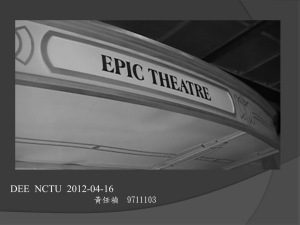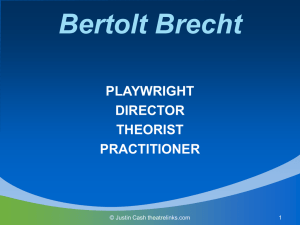3 4 3 6 Specs and Brecht
advertisement
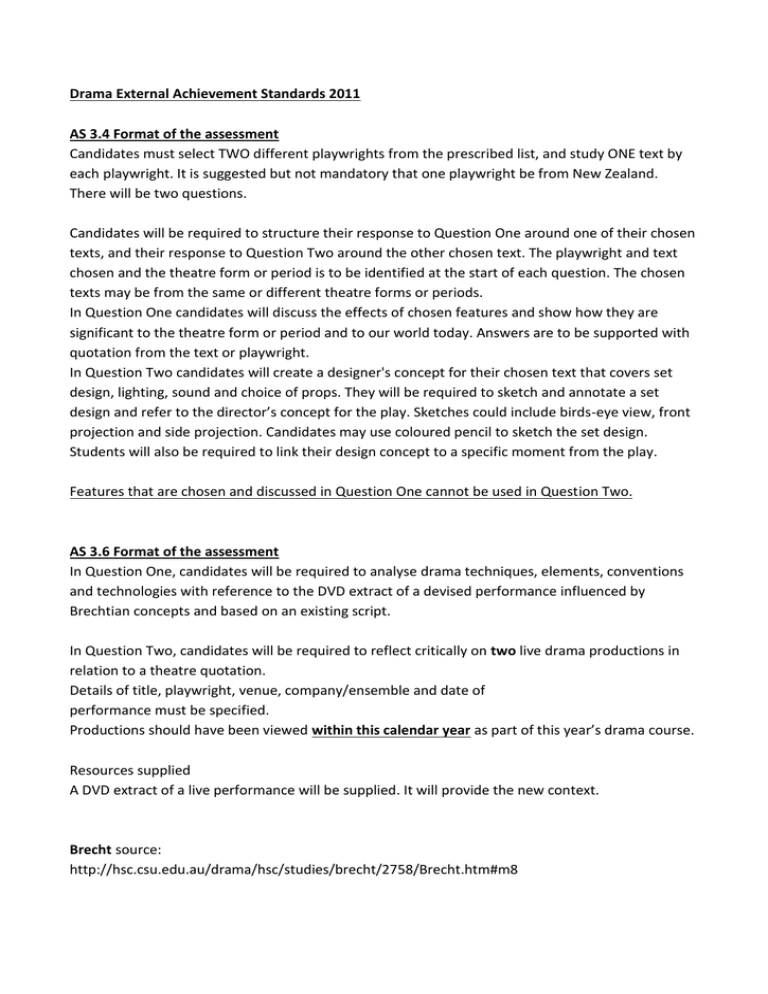
Drama External Achievement Standards 2011 AS 3.4 Format of the assessment Candidates must select TWO different playwrights from the prescribed list, and study ONE text by each playwright. It is suggested but not mandatory that one playwright be from New Zealand. There will be two questions. Candidates will be required to structure their response to Question One around one of their chosen texts, and their response to Question Two around the other chosen text. The playwright and text chosen and the theatre form or period is to be identified at the start of each question. The chosen texts may be from the same or different theatre forms or periods. In Question One candidates will discuss the effects of chosen features and show how they are significant to the theatre form or period and to our world today. Answers are to be supported with quotation from the text or playwright. In Question Two candidates will create a designer's concept for their chosen text that covers set design, lighting, sound and choice of props. They will be required to sketch and annotate a set design and refer to the director’s concept for the play. Sketches could include birds-eye view, front projection and side projection. Candidates may use coloured pencil to sketch the set design. Students will also be required to link their design concept to a specific moment from the play. Features that are chosen and discussed in Question One cannot be used in Question Two. AS 3.6 Format of the assessment In Question One, candidates will be required to analyse drama techniques, elements, conventions and technologies with reference to the DVD extract of a devised performance influenced by Brechtian concepts and based on an existing script. In Question Two, candidates will be required to reflect critically on two live drama productions in relation to a theatre quotation. Details of title, playwright, venue, company/ensemble and date of performance must be specified. Productions should have been viewed within this calendar year as part of this year’s drama course. Resources supplied A DVD extract of a live performance will be supplied. It will provide the new context. Brecht source: http://hsc.csu.edu.au/drama/hsc/studies/brecht/2758/Brecht.htm#m8 Features of Brechtian drama Epic Theatre Brecht called his theatre work by a variety of names, including Epic Theatre, the term now generally used to describe Brecht's plays. His plays tend to be episodic, written as a seemingly disconnected, open-ended montage of scenes presented in a non-naturalistic, non-chronological way. The audience needs to arrive at its own conclusion of how the events are linked together. Epic Theatre presents a sequence of incidents or events that are narrated on a grand scale without the restrictions of time, place or formal plot. The stage Brecht usually left the stage bare in his productions as a means of preventing the audience from experiencing a detailed illusion of reality, of some fictional dramatic location. He exposed stage machinery, opened up the physical staging to the wings and often exposed the back wall. He also exposed the lighting grid above the stage so the audience could see how lights influence the mood of the scene and influence the audience's judgment. Technology The German theatre director, Erwin Piscator, greatly influenced Brecht because he advocated the use of new technologies in the theatre as a means of developing a kind of performance more like the mechanised and accelerated routines of modern life. Brecht used technological effects to fragment the realistic unity of the setting. For instance, he projected films and text on screens above the stage, forcing the audience to relate the action onstage to recent or other historical or social events. (This technique is called historification). He also used placards that announced the action to take place before the scene began, discordant music, songs, constructivist scenery such as scaffolding, projected images and films. Acting style Brecht also developed his own acting style for his work. He urged his actors not to empathise totally with their characters, but to stand outside them and illustrate their behaviour. Brecht's actors were asked to go beyond the Stanislavsky system of acting, where the actor identifies entirely with their character and represents the character entirely from his or her point of view. Rather Brecht encouraged a more demonstrative acting method, one that enables the actor to present the character from a number of perspectives. Movement and gesture The term gestusor grandgestus as used by Brecht, referred to everything an actor did in terms of gesture, stance, body language, facial expressions and intonations in order to show the significance of a scene. The ideal would be that the storyline could be broken down so that each scene can appear as one single action that can be translated into one simple sentence, so that the gestus,(the most important message of the scene, could be made clear. He was also influenced by the theatre of Asia with its use of mime and gesture, clear precise vocal work, symbolic characters and graceful, rhythmic movement. He encouraged his actors to be physically fit and flexible, as his plays sometimes required dance, mime and even acrobatics. Brecht's theatre poems demonstrate his ideas of adopting a new acting style. In "On Everyday Theatre" in Poems of the Crisis Years 1929-1933, Brecht advises actors to observe: that theatre whose setting is the street. The everyday, thousandfold, fameless But vivid, earthy theatre fed by the daily human contact Which takes place in the street. Here the woman from next door imitates the landlord: Demonstrating his flood of talk she makes it clear How he tried to turn the conversation From the burst water pipe...A drunk Gives us the preacher at his sermon, referring the poor To the rich pastures of paradise. How useful Such theatre is though, serious and funny And how dignified! They do not, like parrot or ape Imitate just for the sake of imitation, unconcerned What they imitate, just to show that they Can imitate; no, they Have a point to put across." The alienation effect Brecht also developed the concept of verfremdungseffekt or the alienation effect(sometimes referred to simply as the A-effect). This is one of the principal ideals in Brecht's theory of Drama. Verfremdungseffect translates as "to make strange". It requires the audience and actors to retain a degree of critical detachment from a play and its performance, to be objective and not empathise or identify with the characters or the events that take place in the play. Brecht used various theatrical devices to shock the audience, and keep them conscious of the fact that it was a theatrical performance they were witnessing and that he wanted them to respond in a distanced, objective manner. Some of these techniques included changing the scenery in front of the audience, projections, treadmills, hoists and musicians on the stage. Through using these techniques, Brecht aimed to involve the audience in the process of the play's production and what it was communicating. The audience of Epic Theatre is, therefore invited to consider and enjoy how the theatre fabricates its fiction, rather than passively accepting an illusion of reality onstage. This is Brecht's method of teaching the audience to adopt a more critical, alienated way of seeing real life. Thus the intention of his theatre practice is didactic. Brecht wanted to distance his audience emotionally from the action of his plays, unlike Polly Peachum's businessman father, Mr J.J. Peachum, who tells his daughter in The Threepenny Opera, "There is of course a difference between playing on people's feelings and getting on their nerves. Only an artist can still play on people's feelings nowadays."


